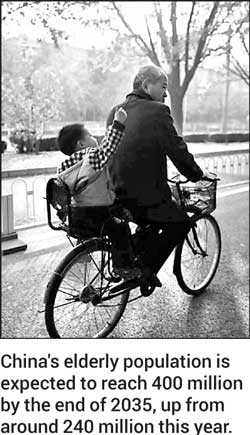Tuesday Mar 11, 2025
Tuesday Mar 11, 2025
Saturday, 24 November 2018 00:00 - - {{hitsCtrl.values.hits}}
 SHANGHAI (Reuters) : The population of China’s capital, Beijing, fell for the first time in two decades in 2017, the official Xinhua news agency reported, citing official data.
SHANGHAI (Reuters) : The population of China’s capital, Beijing, fell for the first time in two decades in 2017, the official Xinhua news agency reported, citing official data.
The number of permanent residents reached 21.707 million last year, 22,000 fewer than the previous year, Xinhua said late on Thursday.
The number of people in the city’s six urban districts fell 3% from 2016 to 2017, the Xinhua report said, citing the city’s People’s Congress.
Authorities in Beijing have been making efforts to curb population growth as part of their efforts to ease traffic congestion, resource shortages and house price inflation.
Beijing’s population has risen by two thirds since 1998, while energy consumption has more than doubled and the number of vehicles tripled. It said in 2016 it would take action to cap its population at 23 million by the end of the decade.
The city has been working on integrating its economy with the neighbouring province of Hebei and the city of Tianjin in a bid to allow some of its universities, government departments and industrial firms to move out.
It has also set up a new development zone at Xiongan in Hebei to take on some of Beijing’s “non-capital” functions, and is also investing heavily on transportation networks in order to make it easier for long-distance commuters.
While big cities like Beijing and Shanghai have sought to control population growth, China as a whole is trying to take action to boost its birth rate, which fell in 2017 and is expected to decline further this year.
China’s elderly population is expected to reach 400 million by the end of 2035, up from around 240 million this year, putting its health services and pension funds under immense strain, according to data published last year by the China Association of Social Security, a research group.
Discover Kapruka, the leading online shopping platform in Sri Lanka, where you can conveniently send Gifts and Flowers to your loved ones for any event including Valentine ’s Day. Explore a wide range of popular Shopping Categories on Kapruka, including Toys, Groceries, Electronics, Birthday Cakes, Fruits, Chocolates, Flower Bouquets, Clothing, Watches, Lingerie, Gift Sets and Jewellery. Also if you’re interested in selling with Kapruka, Partner Central by Kapruka is the best solution to start with. Moreover, through Kapruka Global Shop, you can also enjoy the convenience of purchasing products from renowned platforms like Amazon and eBay and have them delivered to Sri Lanka.
Discover Kapruka, the leading online shopping platform in Sri Lanka, where you can conveniently send Gifts and Flowers to your loved ones for any event including Valentine ’s Day. Explore a wide range of popular Shopping Categories on Kapruka, including Toys, Groceries, Electronics, Birthday Cakes, Fruits, Chocolates, Flower Bouquets, Clothing, Watches, Lingerie, Gift Sets and Jewellery. Also if you’re interested in selling with Kapruka, Partner Central by Kapruka is the best solution to start with. Moreover, through Kapruka Global Shop, you can also enjoy the convenience of purchasing products from renowned platforms like Amazon and eBay and have them delivered to Sri Lanka.